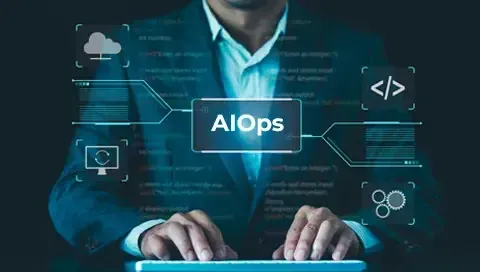The artificial intelligence landscape is evolving beyond simple task automation toward intelligent, human-assisted AI agents. Modern AI agents don’t just follow instructions; they reason complex problems, adapt to changing conditions, and make strategic decisions independently or with human-in-the-loop.
As organizations seek to implement these sophisticated AI systems, the challenge lies in understanding how to architect agents that can handle real-world enterprise complexity. This requires moving beyond basic AI models to embrace Agentic AI — systems that exhibit advanced autonomy and strategic reasoning capabilities.
In this comprehensive post, we’ll explore the foundational concepts of AI agents, the design patterns that make them effective, and how organizations can implement these patterns to solve complex business challenges.
Understanding AI Agents: The Foundation of Modern AI Systems
Before exploring how to design and implement effective AI agent systems, it’s essential to understand what makes an AI agent truly intelligent. An AI agent operates on six fundamental capabilities that distinguish it from traditional AI models:
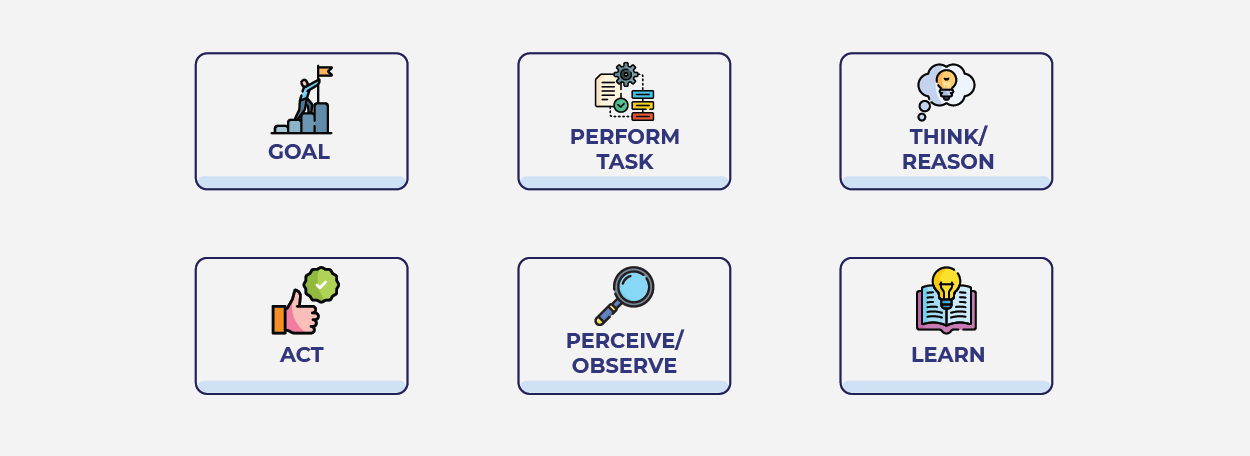
Core capabilities of an intelligent AI agent: goal setting, task execution, reasoning, action, perception, and learning to support adaptive performance.
Core AI Agent Capabilities
- Goal Setting: Every agent operates with defined objectives
- Task Execution: Performing complex operations in dynamic environments
- Reasoning: Processing information and making informed decisions
- Action Taking: Implementing decisions that affect the environment
- Perception: Continuously gathering and analyzing environmental data
- Learning: Improving performance through experience and feedback
These capabilities enable AI agents to function with human assistance across diverse applications, from customer service automation to enterprise workflow management.
What is Agentic AI and Why It Matters?
Agentic AI represents the next evolution in artificial intelligence, moving beyond simple task execution to exhibit advanced autonomy and strategic reasoning. Unlike traditional AI models that follow predefined instructions, Agentic AI systems use iterative planning and contextual reasoning to solve complex, multi-step problems independently or with human-in-the-loop.
Key Characteristics of Agentic AI

Key characteristics of Agentic AI including autonomy, adaptive learning, language understanding, workflow optimization, and multi-agent collaboration.
- Natural Language Processing: Advanced interpretation and generation capabilities
- Workflow Optimization: Automated process streamlining across systems
- Multi-agent Coordination: Seamless collaboration between different AI systems
- Autonomous Decision Making: Independent operation based on environmental inputs
- Adaptive Learning: Continuous improvement through experience
Building Blocks of Effective AI Agents
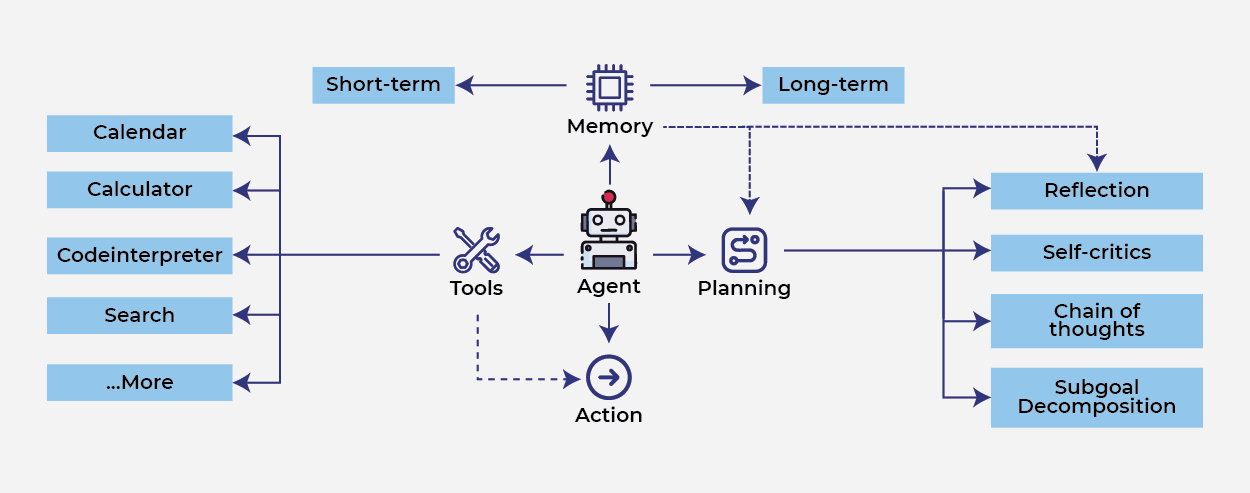
Architecture of an intelligent AI agent system featuring memory, tool integration, planning, and action components for building context-aware and self-improving agents.
Creating truly autonomous AI agents requires four fundamental components working in harmony:
Memory Systems
Memory enables context-aware decision-making through two distinct layers:
- Short-term Memory: Maintains context during active tasks and conversations
- Long-term Memory: Stores accumulated knowledge and experiences for future reference
Tool Integration
Modern AI agents extend their capabilities through dynamic tool usage. These are some of the examples highlighted below:
- Calendar Management: Scheduling and time-based operations
- Computational Tools: Mathematical calculations and data processing
- Code Execution: Running and analyzing programmatic solutions
- Web Search: Real-time information retrieval and research
Planning Mechanisms
Strategic planning enables agents to handle complex objectives:
- Reflection: Analyzing past actions for improved future decisions
- Self-evaluation: Identifying performance gaps and optimization opportunities
- Chain of Thought: Structured, step-by-step reasoning processes
- Subgoal Decomposition: Breaking complex tasks into manageable components
Action Implementation
The execution layer where agents interact with their environment and implement decisions in real-time.
Agent Design Patterns for Enterprise Applications
Effective AI agent deployment requires selecting appropriate architectural patterns based on task complexity and system requirements. We’ll explore these patterns in order of increasing complexity, starting with single-agent patterns and progressing to multi-agent architectures.
Tool Use Pattern
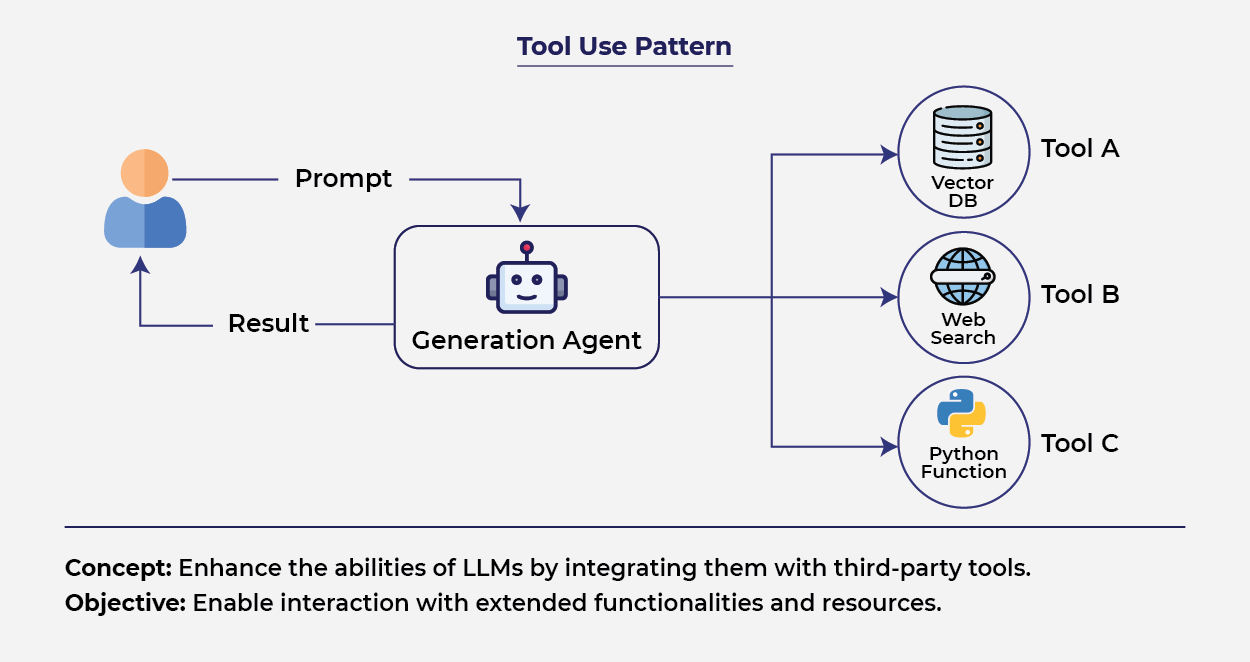
Tool Use Pattern for AI agents: a generation agent uses third-party tools like vector databases, web search, and Python functions to generate enriched responses.
Enables agents to leverage external capabilities:
- Generation Agent: Identifies tool requirements
- Tool Integration: Connects with databases, APIs, and computational resources
- Use Case: Data analysis, research, and technical problem-solving
The tool use pattern extends agent capabilities in real-time, enabling access to current information, computational abilities, and external systems. This pattern forms the foundation for more sophisticated agent behaviors, as most advanced agents require tool integration to be truly effective.
Planning Pattern
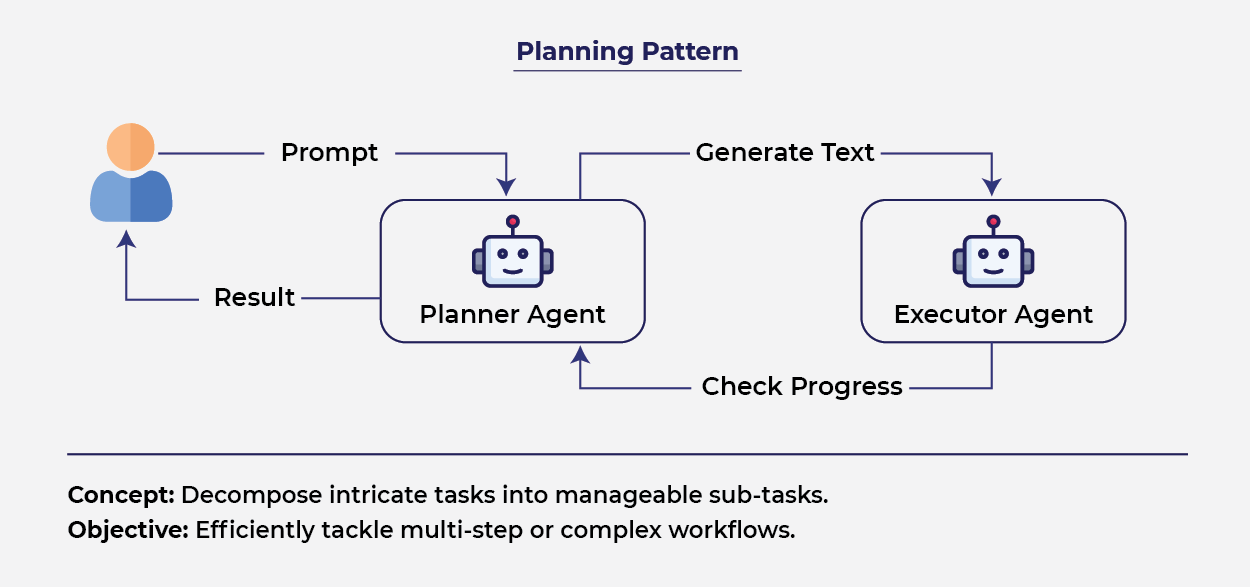
Planning Pattern for AI agents: a planner agent breaks down tasks and delegates them to an executor agent, enabling efficient multi-step workflow management.
Separates strategic planning from tactical execution:
- Planner Agent: Decomposes complex tasks into actionable steps
- Executor Agent: Implements individual task components
- Use Case: Project management automation and multi-step workflows
This pattern excels in scenarios requiring complex, multi-step processes where strategic thinking must be separated from execution. The planner agent can leverage tools to gather information and create comprehensive execution plans.
Reflection Pattern
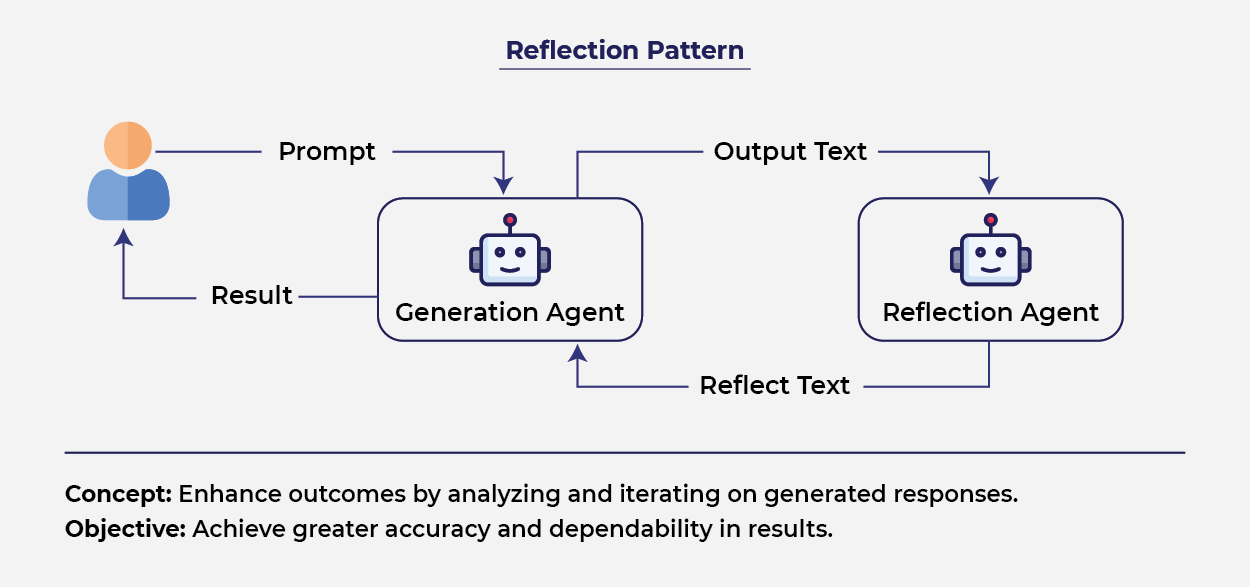
Reflection Pattern in AI agents: the generation agent produces initial output, which is reviewed and refined by a reflection agent to improve accuracy.
This pattern implements a feedback loop for continuous output improvement:
- Generation Agent: Creates initial responses
- Reflection Agent: Evaluates and refines outputs
- Use Case: High-accuracy content creation and decision support systems
The reflection pattern is particularly valuable when accuracy and quality are paramount. The agent generates an initial response, then critically evaluates and refines it, leading to higher-quality outputs. This pattern can incorporate both tool use and planning capabilities.
Multi-Agent Architecture Patterns
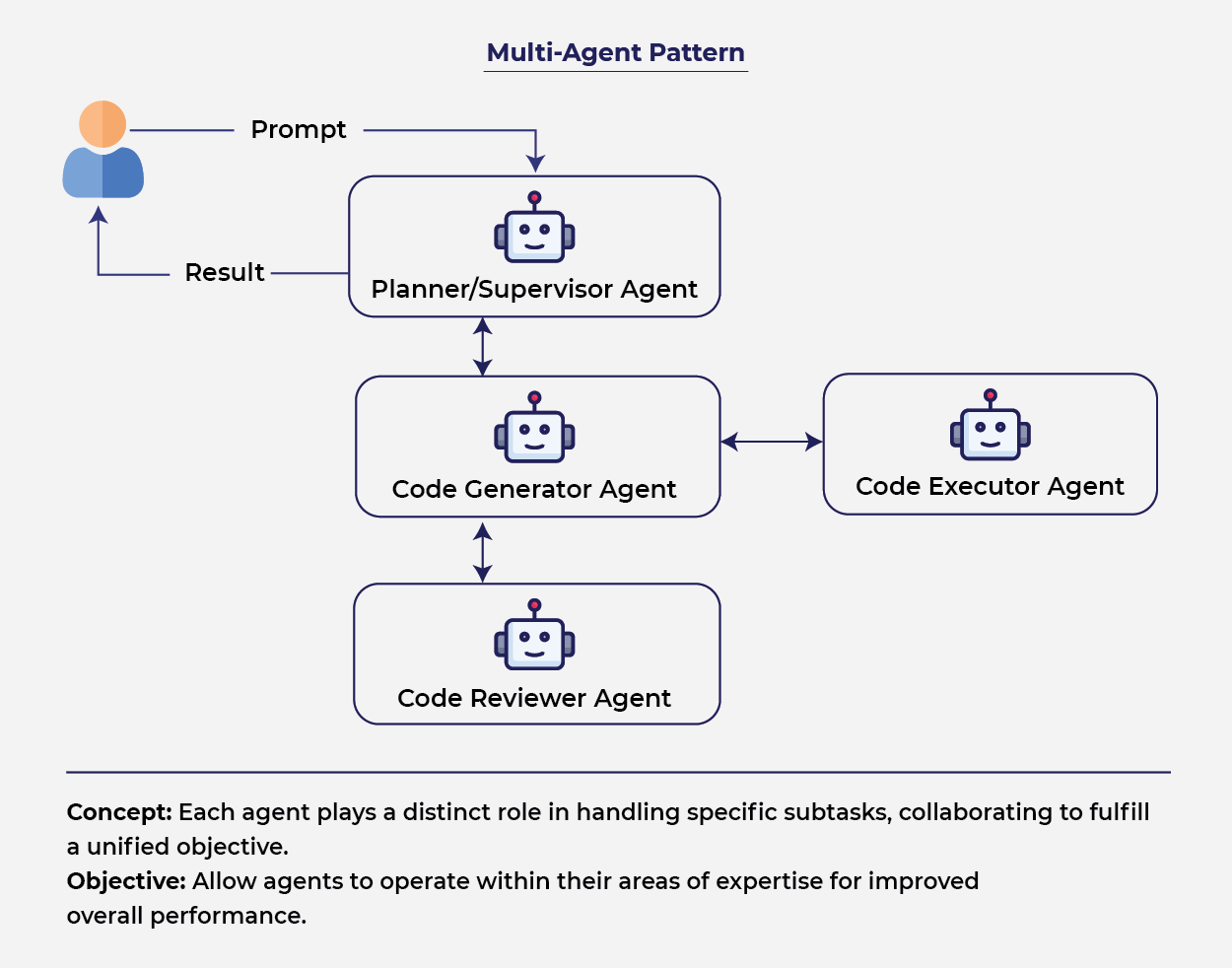
Multi-Agent Pattern for collaborative AI systems: specialized agents such as planner, code generator, reviewer, and executor work together to complete complex tasks efficiently.
As AI systems scale, distributing responsibilities across specialized agents becomes essential for maintainability and performance. These patterns build upon the single-agent foundations we’ve established.
Sequential Multi-Agent Pattern
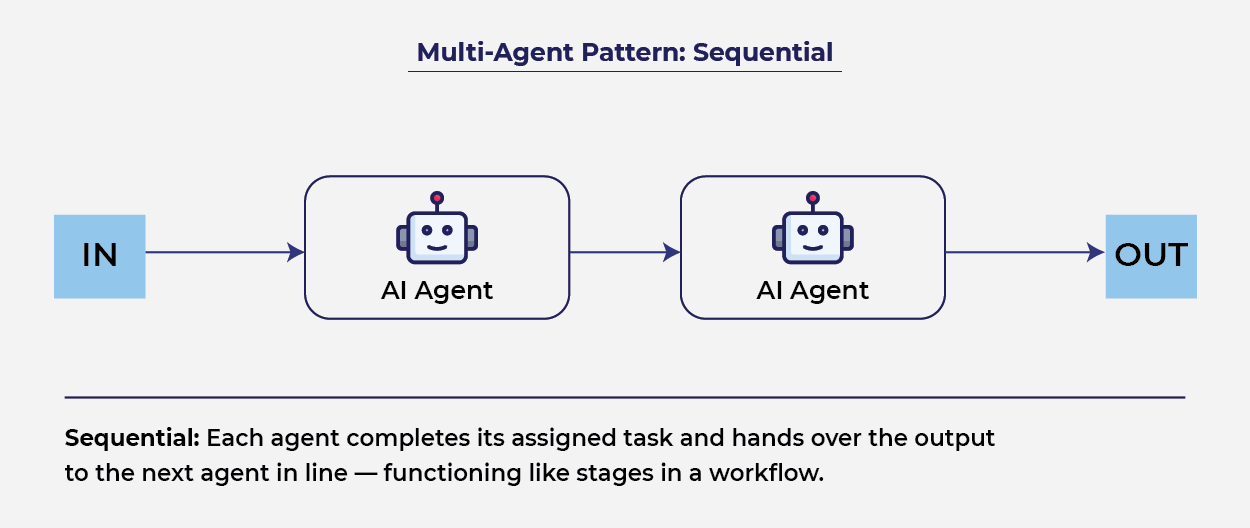
Sequential Multi-Agent Pattern: each AI agent processes its task and passes the output to the next, forming a step-by-step workflow.
Agents operate in a linear workflow where each step depends on the previous output:
Input → Agent 1 → Agent 2 → Agent 3 → Output
Best for: Document processing, data transformation pipelines, staged decision-making
This pattern ensures that each agent builds upon the work of the previous one, creating a reliable processing pipeline. Each agent in the sequence can employ tool use, planning, or reflection patterns as needed.
Parallel Multi-Agent Pattern
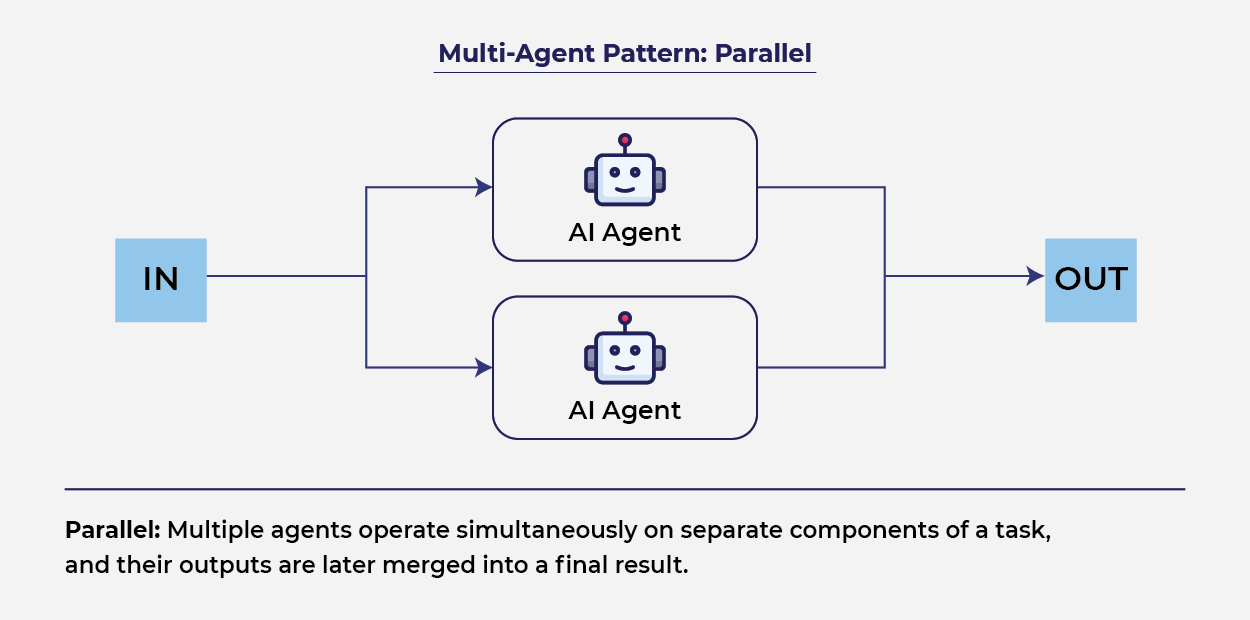
Parallel Multi-Agent Pattern: multiple AI agents work simultaneously on different parts of a task, combining their outputs into a single result.
Multiple agents work simultaneously on different aspects of a task:
Input → [Agent A, Agent B, Agent C] → Aggregated Output
Best for: Real-time analysis, multi-modal processing, concurrent evaluations
Parallel processing reduces overall execution time and allows for diverse perspectives on the same problem. Each parallel agent can utilize the full spectrum of single-agent patterns independently.
Router Pattern
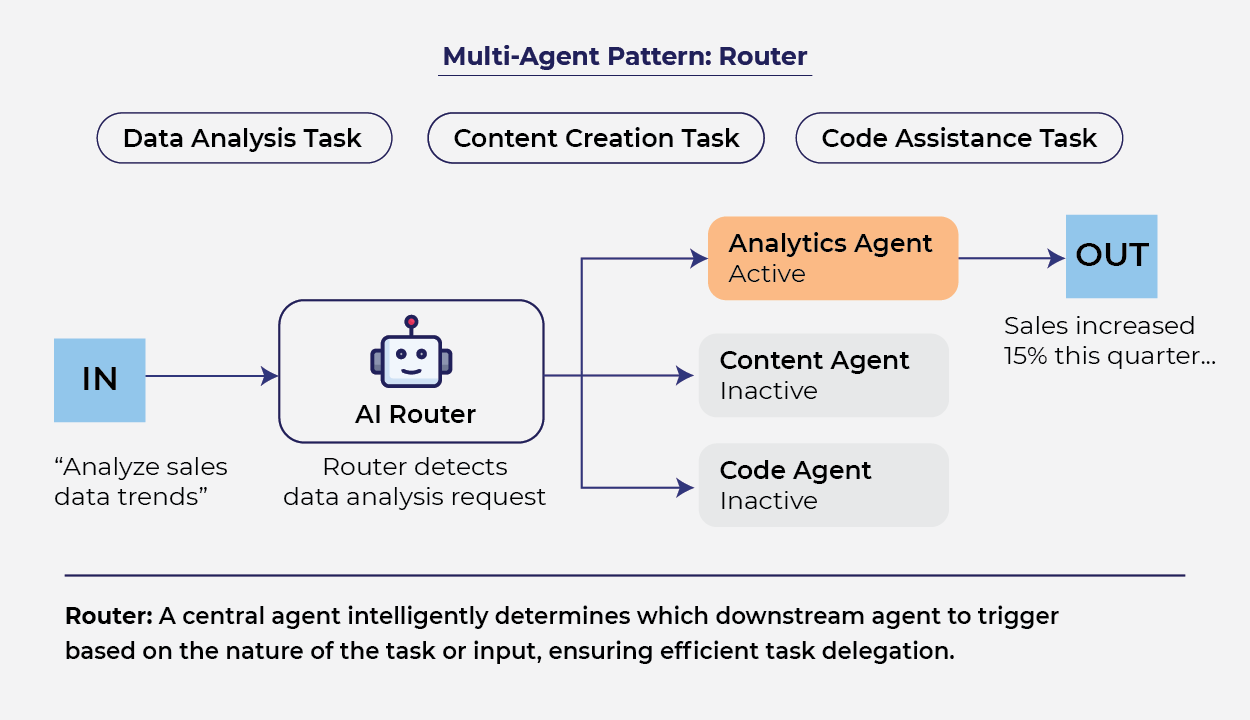
A central AI agent dynamically delegates tasks to specialized downstream agents based on input type, enabling efficient and intelligent task routing.
A central agent dynamically assigns tasks to specialized agents:
Input → Router Agent → [Specialist Agent A or B] → Output
Best for: Customer support systems, multi-domain assistants
The router pattern provides intelligent task distribution based on content analysis and agent capabilities. The router itself often employs reflection patterns to make optimal routing decisions.
Loop Pattern
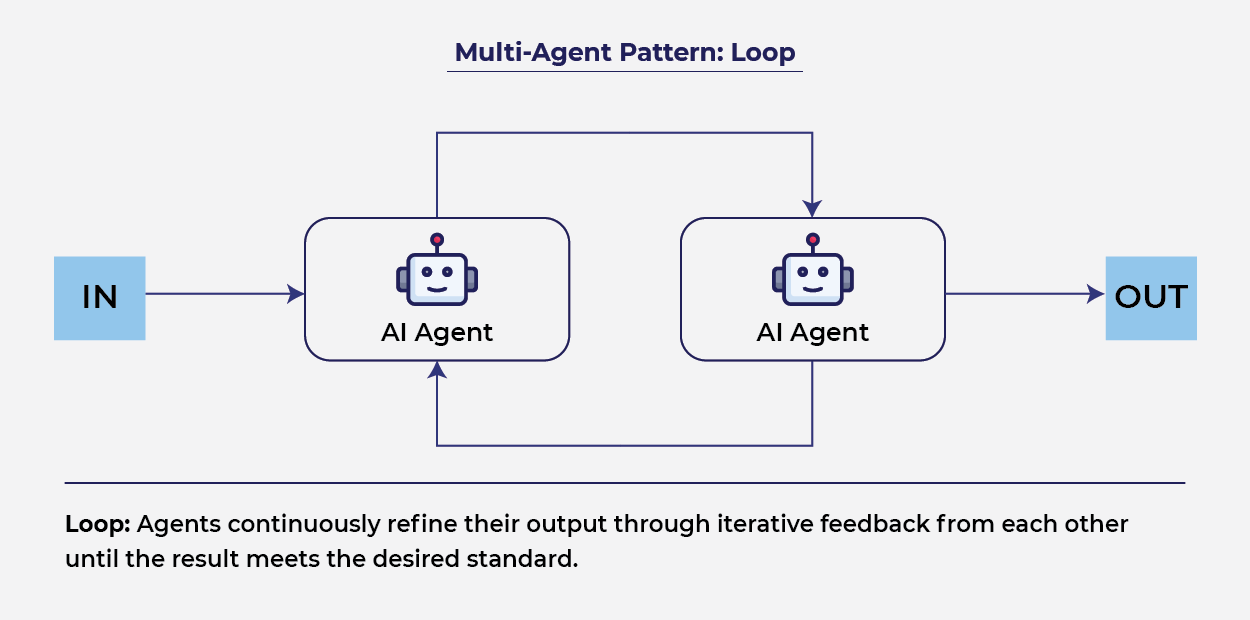
Two AI agents collaborate in an iterative feedback loop, refining outputs continuously until optimal results are achieved.
Agents continuously refine outputs through iterative collaboration:
Input → Agent A ↔ Agent B → Refined Output
Best for: Creative tasks, code generation, iterative problem-solving
The loop pattern enables continuous improvement through collaborative refinement between specialized agents. This pattern often combines reflection capabilities with multi-agent coordination.
Hierarchical Pattern
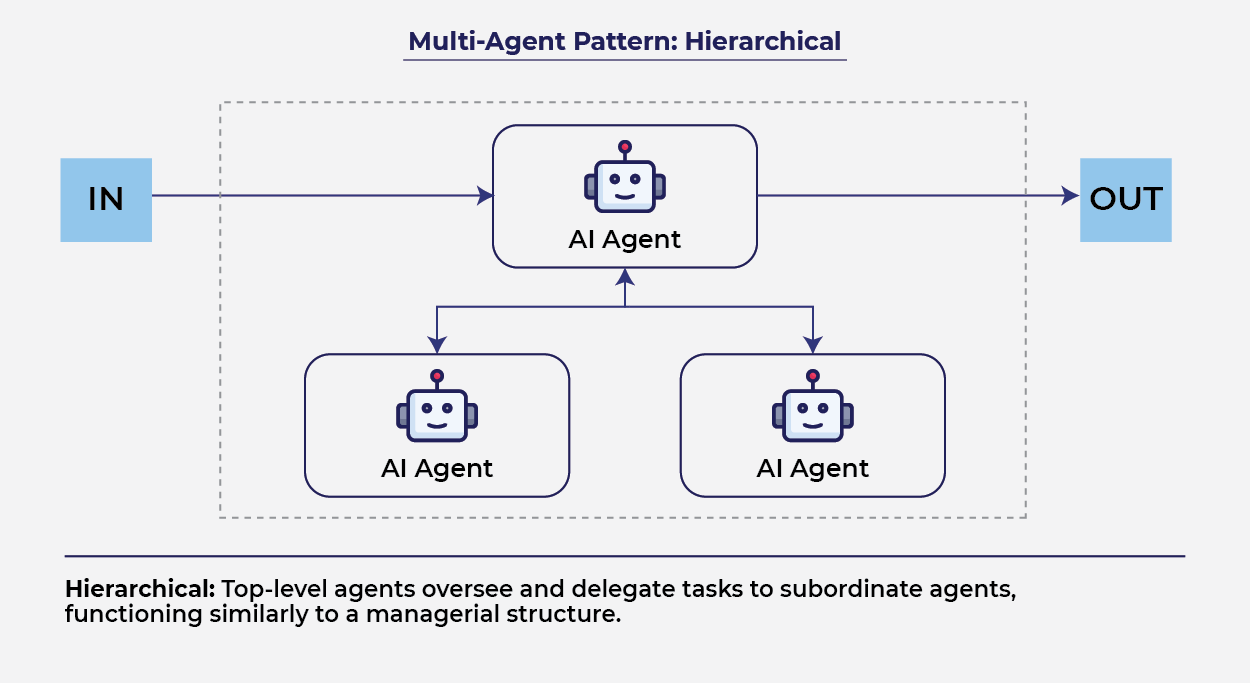
A top-level AI agent manages and delegates tasks to subordinate agents, mirroring organizational structures for scalable task execution.
Structured delegation mimicking organizational hierarchies:
Input → Supervisor Agent → [Worker Agent A, Worker Agent B] → Output
Best for: Enterprise applications, project management, automated workflows
This pattern mirrors traditional organizational structures, making it intuitive for enterprise adoption. Supervisor agents typically employ planning and reflection patterns, while worker agents focus on specialized tool use.
Industry Specific Applications
Financial Services
- RFP Intelligence Agents: We’ve delivered web-browsing and document extraction agents that autonomously scan RFP portals, extract requirements, map them to internal capabilities, and generate draft responses — accelerating pre-sales turnaround.
- Fraud Pattern Detection Agents: Leveraging parallel processing, our systems analyze transaction flows and behavioral fingerprints in real time to surface anomalous activities and trigger compliance workflows.
- Advisor Routing Agents: Cybage has designed agent systems that triage incoming customer queries and dynamically route them to the appropriate wealth or compliance advisors, based on query complexity and portfolio history.
Healthcare
- Diagnostic Support Agents: For health-tech clients, we’ve designed sequential reasoning agents that process symptoms, lab results, and historical context to recommend potential diagnoses and treatments — helping providers reduce decision fatigue.
- Medical Research Agents: In data-heavy research settings, our agents support hypothesis testing loops, enabling researchers to simulate variables, validate outcomes, and refine clinical trials faster.
Manufacturing
- Production Quality Agents: Cybage has delivered tool-integrated edge agents for factory floors, running continuous checks on parameters like temperature variance, throughput deviation, and defect rates to catch issues early.
- Supply Chain Coordination Agents: We’ve built multi-agent planning systems that assess live inventory, vendor ETA, and seasonal trends to automate replenishment across nodes in the supply chain.
Retail and E-commerce
- Store Support Agents: For global retailers, we’ve built mobile-enabled field agents that assist store staff in validating catalogue info, scanning inventory health, and forecasting footfall based on local conditions.
- Customer Personalization Agents: Our agent systems aggregate clickstream, weather, and location data to deliver personalized product suggestions in real-time, boosting conversion.
- Inventory Forecasting Agents: We’ve implemented planning-based agent flows to balance warehouse stock levels and reorder thresholds based on projected regional demand and vendor latency.
Media & Advertising
- Budget Optimization Agents: Cybage has delivered multi-agent simulators that recommend budget allocation across geographies, time slots, and media formats — dynamically learning from past RoI trends.
- Crawling & Proposal Agents: Our media partners use autonomous browsing agents to identify new campaign or RFP opportunities, extract key metrics, and prepare near-complete response templates.
Cybersecurity
- Firewall & Threat Scanning Agents: We’ve deployed real-time cybersecurity agents that continuously monitor firewall logs, scan for CVE threats, and autonomously suggest or apply remediations when risks are detected.
How Cybage Enables Agentic AI Implementation
Cybage brings deep expertise in AI agent development to help organizations build scalable, intelligent AI systems. Our comprehensive approach includes:
Technical Implementation Services
Agent Architecture Design
Custom agent design patterns based on business requirements, multi-agent orchestration for complex workflows, and performance optimization planning.
Enterprise Integration
Seamless connection with existing business systems, legacy system compatibility through API bridges, and real-time data synchronization.
Development and Deployment Support
Proof of Value Development
Rapid prototyping of agent systems, use case validation, and technology stack evaluation.
Production Implementation
Full-scale agent deployment with monitoring, performance tuning, and integration testing.
Training and Knowledge Transfer
Technical Training
Agent design workshops, best practices training, and hands-on development for internal teams.
Business Process Integration
Workflow analysis, change management support, and success metrics definition.
What’s Next: Agent-to-Agent Communication
While single and multi-agent patterns provide powerful solutions within individual systems, the future of enterprise AI lies in enabling agents from different platforms and organizations to communicate seamlessly.
In our next blog post, “Building Intelligent AI Ecosystems with Google’s A2A Protocol — Part 2”, we’ll explore:
- How agents can communicate across different platforms and frameworks
- Google’s Agent-to-Agent (A2A) Protocol for standardized agent communication
- Real-world implementation examples and code samples
- Integration patterns for enterprise-scale agent ecosystems
- Advanced orchestration techniques for cross-platform agent collaboration
Conclusion
Agentic AI represents a fundamental shift toward more autonomous and intelligent systems. By understanding and implementing appropriate agent design patterns, organizations can build AI solutions that not only perform tasks but also reason, plan, and adapt to changing requirements.
The patterns we’ve explored — from simple reflection loops to complex hierarchical systems — provide the foundation for building sophisticated AI agents that can handle real-world enterprise challenges. Success lies in selecting the right pattern for your specific use case and implementing it with careful attention to scalability and maintainability.
As we move toward more interconnected AI ecosystems, these foundational patterns become even more important. They provide building blocks for agents that can not only work effectively within their systems but also collaborate seamlessly with agents across different platforms and organizations.
Ready to explore how Agentic AI can transform your business processes? Contact Cybage to discuss your specific requirements and learn how our expertise can help you build intelligent, autonomous AI systems that drive business success.
Stay tuned for Part 2, where we’ll explore the technical implementation of Google’s A2A Protocol and show you how to build truly interconnected AI agent ecosystems that can communicate and collaborate across any platform or framework.









